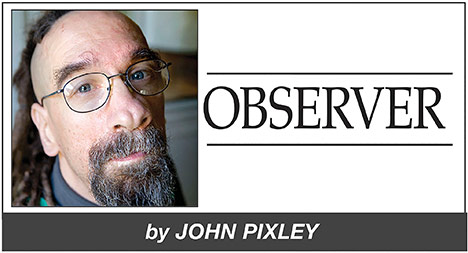VIEWPOINT Train wreck
by Ludd A. Trozpek
Attending last week’s meeting of Claremont’s Traffic and Transportation Commission, where the Gold Line and Metrolink dominated the agenda, it seemed like just another sorry chapter of irrelevance, reaction and submissiveness that has marked the city’s responses at every turn over the past two years.
Recall that these matters boiled into public notice in early 2016 when the Gold Line Construction Authority muckety-mucks announced their plan to make a “minor” addendum to the Gold Line EIR to allow a grade separation at Indian Hill. “Grade separation” is transportation technobabble for a bridge or an underpass, the idea being that 20 or more trains per hour all day long, halting traffic on Indian Hill for a minute or two at a time, might possibly, maybe, discommode traffic on Indian Hill.
These presentations were never made in the regular order: one came during the ceremonial section of a council meeting; another was in the early morning when the presenters and city hijacked a Village Marketing Group meeting; a third was a few weeks later at a Sustainable Claremont meeting.
It should be noted that although the Gold Line CEO attempted to salve the audiences by claiming that he was here to “listen,” it was clear that the only alternative he was willing to entertain to bollixed traffic was a quarter-mile-long, 25-foot-high monstrosity of a bridge walling off south Claremont from the Village. It was hideous.
He wasn’t listening; he was telling. In fact, the EIR addendum was already well along at this point, specifying a bridge, and through a tricky CEQA loophole ignoring the environmentally superior option of an underpass for the trains. The Traffic and Transportation Commission (TTC) was fenced out of the discussion completely.
In response to the Gold Line’s injunction to rush-rush-hurry-hurry, council quickly held a meeting to brag it had bought the community a year to decide: grade separation or no? It would be thoroughly and thoughtfully studied in the Claremont Way.
However, a mere five months later, in July, unwilling effectively to do anything, and with no commission input, council decided out of the clear blue: Keep the trains and traffic at grade and live with the mess. That’s how it sat for almost a year.
Meanwhile, in November 2016, voters approved Metro Measure M, a sales tax increase amounting to one percent with no sunset, forecast to yield nearly $3 billion a year in revenue, world without end. It was a huge Christmas tree of funding for Metro, the Gold Line, the Construction Authority and cities. (The entire budget for the Gold Line extension to Claremont amounts to only about $1.5 billion—merely six or seven months take. This measure produces a fantastic amount of money.) Early this summer, rumblings were heard that all was not well with the council’s decision.
As the Gold Line Construction Authority doubtless already had known, but failed to mention the prior year, the California Public Utilities Commission, charged by state law with regulating railroad crossings, was viewing the Indian Hill at-grade crossing by the Gold Line and Metrolink with disfavor on safety and congestion grounds.
When this became known to the city is a matter of debate. Either it was known all along, and the information withheld, or the city was clueless for a year. Whichever, it doesn’t speak well for city staff, council and Claremont’s Gold Line Construction Authority representative.
This brings the story up to date on this front. The Assistant City Manager Colin Tudor presented a plan for a bridge over Indian Hill to the TTC on Thursday. He advised against challenging the putative Public Utilities Commission decision against two sets of tracks at grade on Indian Hill. What he failed to provide was any data, or any complete analysis of alternatives. He fundamentally carried the water for the Gold Line Construction Authority, as he will presumably do when this is taken up by council on October 10.
Traffic study? None completed. Parking requirements? To be determined. Alternatives? Dismissed or unmentioned in favor of the preferred narrative. The commissioners approved the staff recommendation on a unanimous vote.
There are few places in the Metro system other than Claremont where four tracks, two each for the Gold Line and Metrolink trains, are crammed into a 65- to 75-foot right of way. This situation exists for nearly a half mile in Claremont around Indian Hill, the center of the Village. This fact alone would seem to require extraordinary measures on the part of the city and the Gold Line to mitigate harms.
The obvious solution is to depress the Gold Line below grade as is done for some length in Pasadena. This solves every problem: noise, safety, traffic, viewshed, circulation. But the city so far—staff and the TTC—has docilely accepted the Gold Line’s bridge.
Staff always speaks darkly of the cost of a depressed line, as if it is infeasible. But remember, Metro has several billions of dollars per year of revenue forever, and the additional cost, if any, amounts to only a few days or weeks of revenue.
In fact, Metro is “playing poor,” and claiming there is a funding gap already. We are constantly reminded of that. This is bureaucratic sleight-of-hand and shouldn’t be taken seriously: If they weren’t confident of having the money, they wouldn’t start the project. And they have just started the project with the first contract announced this week. Neither is there any insoluble technical issue. The big boys have simply decided on a bridge, and that’s that.
In the past week or two, another clod was thrown into the churn by Supervisor Hilda Solis who proposed a study to eliminate the Claremont Metrolink station. This idea garnered no support and much consternation by the TTC last week, with some members ruing their support for the Measure M sales tax increase and speculating about bad motives at Metro for its bait and switch. (News flash: that’s what Metro does. Refer to the history of Measure R.)
It’s especially rich that Sam Pedroza, who sits on the Gold Line Construction Authority board and who was once a staffer for Ms. Solis, complains of being blindsided by this proposal. However, with every challenge comes opportunity. If there were no Metrolink stop in Claremont (Pomona and Montclair would remain), perhaps the Metrolink tracks could be depressed as well, and perhaps the 1,260-car parking structure, which will stand three stories and span the south side of First Street from College halfway to Claremont Boulevard, could be downsized.
Maybe there could be a valid traffic study. Perhaps the trains could be separated from traffic at Claremont Boulevard and make it a more viable north-south thoroughfare. But of course, no thinking along any of these lines was mentioned at the TTC meeting, except by audience members who could safely be ignored. So now, even the baseline design, for which all the EIRs were written, is up in the air.
Claremont is not being well-served by its elected or appointed officials or hired hands. Instead of defining and advocating for the best interests of the community, they are passively accepting whatever crumbs are being handed down from above. So don’t be surprised in a decade when the Village is a congested, noisy, unsafe, unreachable mess. That’s the path being taken.









0 Comments